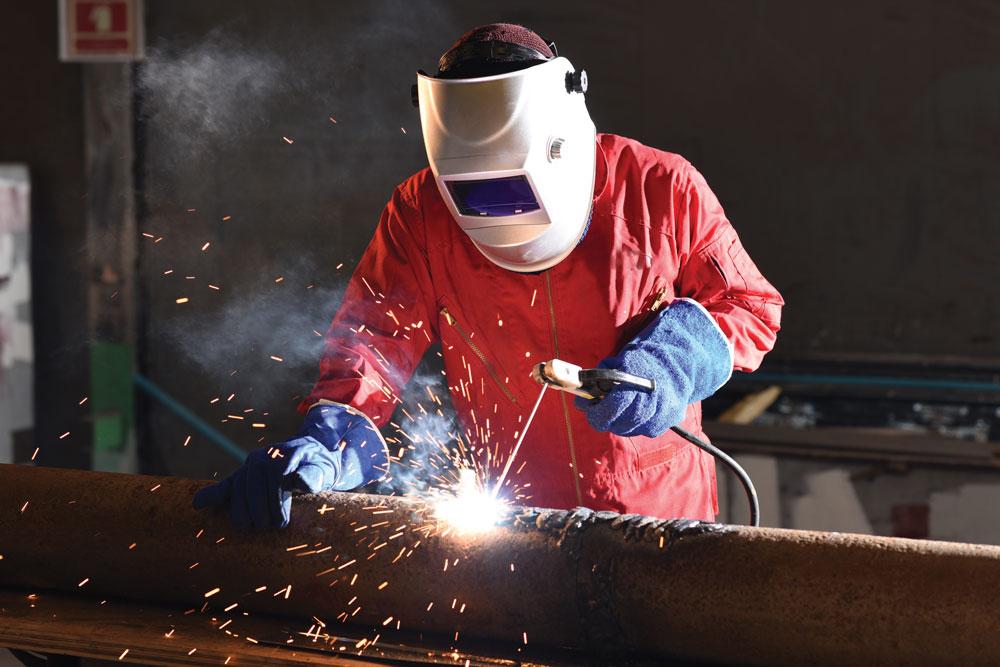The Ultimate Guide to Welding Inspection Racine for Industrial Criteria
The Ultimate Guide to Welding Inspection Racine for Industrial Criteria
Blog Article
Cutting-edge Approaches to Fillet Weld Inspection and Testing: Enhancing Weld Quality and Compliance Standards
In the world of welding, the high quality and integrity of fillet welds play an essential function in ensuring the structural sturdiness and dependability of various commercial components. With the consistent drive for enhanced efficiency and conformity with strict criteria, the exploration of cutting-edge methods to fillet weld assessment and testing has actually become essential.
Advanced Non-Destructive Testing Techniques
Using advanced technologies, advanced non-destructive testing approaches play an important duty in making sure the honesty and high quality of fillet welds. These approaches, such as phased array ultrasonic testing (PAUT) and magnetic fragment testing (MPT), offer thorough insights into the weld's inner framework without causing any type of damages to the material. PAUT, for example, makes use of multiple ultrasonic elements to check the weld from various angles, giving a comprehensive visualization of prospective flaws like absence of fusion or fractures.
In A Similar Way, MPT works in spotting surface-breaking flaws by using a magnetic area and iron particles to the weld area. This method is especially valuable for recognizing suspensions that may jeopardize the weld's stamina. By utilizing these innovative non-destructive testing methods, weld examiners can properly analyze the top quality of fillet welds, ensuring compliance with industry standards and regulations. The ability to spot defects beforehand not only improves weld top quality yet additionally protects against pricey rework or failings in architectural stability, highlighting the significance of these innovative testing approaches in welding inspections.
Robotics and Automation in Assessment
The integration of robotics and automation has actually reinvented the evaluation procedure for fillet welds, improving efficiency and precision in quality analysis. Robotics use accurate control and repeatability in inspecting welds, guaranteeing consistent and trustworthy outcomes. Automated systems can be programmed to follow details evaluation courses, guaranteeing detailed protection of welds and lowering the risk of human mistake.
Robotic assessment systems equipped with sophisticated sensing units can spot and gauge weld features with high precision, giving comprehensive information for analysis. These systems can recognize defects such as fractures, absence of fusion, and porosity, allowing punctual restorative activities to be taken. In addition, robotics and automation allow for real-time data collection and evaluation, giving immediate feedback to drivers and assisting in fast decision-making processes.
Moreover, making use of robotics and automation in fillet weld assessment enhances total efficiency by lowering examination times and raising evaluation throughput. By enhancing the assessment procedure, producers can make sure weld top quality and conformity criteria are fulfilled successfully, ultimately leading to cost financial savings and enhanced product quality.
Utilizing Artificial Intelligence for Analysis
Synthetic knowledge plays an essential role in boosting the effectiveness and precision of analysis in fillet weld inspection procedures. AI algorithms can swiftly process substantial amounts of information from weld evaluations, detecting flaws or disparities that might be challenging to recognize with the naked eye - Welding Inspection Racine.
Moreover, AI systems can discover from previous evaluation information, consistently improving their capability to recognize potential flaws and inconsistencies in fillet welds. This adaptive knowing ability boosts the overall quality assurance procedure, lowering the likelihood of human error and making sure that welds fulfill the called for standards. By integrating synthetic knowledge right into fillet weld evaluation, sectors can achieve higher levels of effectiveness, view it now uniformity, and conformity in their evaluation practices.
Portable Tools for On-Site Evaluation
 Enhancing area evaluation efficiency, the fostering of mobile devices transforms on-site analysis processes for fillet welds. These devices provide flexibility and benefit, enabling examiners to carry out detailed examinations in various locations, including challenging or remote environments. Mobile tools such as ultrasonic testing devices, magnetic bit examination devices, and digital radiography systems supply real-time information and high-resolution imaging capacities, making it possible for quick decision-making and immediate feedback on redirected here weld high quality.
Enhancing area evaluation efficiency, the fostering of mobile devices transforms on-site analysis processes for fillet welds. These devices provide flexibility and benefit, enabling examiners to carry out detailed examinations in various locations, including challenging or remote environments. Mobile tools such as ultrasonic testing devices, magnetic bit examination devices, and digital radiography systems supply real-time information and high-resolution imaging capacities, making it possible for quick decision-making and immediate feedback on redirected here weld high quality.One considerable benefit of mobile tools is their capacity to streamline evaluation procedures, minimizing downtime and boosting general productivity. Inspectors can easily carry these tools to different task sites, eliminating the requirement for transferring hefty machinery or elements to off-site centers. Additionally, the transportability of these devices advertises cost-effectiveness by lessening transport costs and accelerating examination timelines.
Moreover, using portable tools for on-site examination promotes proactive quality control procedures, as examiners can without delay recognize and resolve any potential welding defects or inconsistencies. By incorporating these innovative technologies right into on-site inspection methods, welding specialists can make sure compliance with market standards and improve weld top quality, ultimately causing improved architectural honesty and security in numerous welding applications.
Assimilation of Data Administration Equipment
Having maximized on-site evaluation procedures via the usage of portable tools, the following stage involves the seamless combination of data monitoring systems to additionally boost efficiency and data evaluation capabilities in fillet weld evaluation and screening. Welding Inspection Racine. By integrating data monitoring systems right into the assessment procedure, companies can enhance information collection, storage space, and analysis. This integration enables real-time tracking of weld high quality, instant recognition of flaws, and prompt decision-making to fix any kind of problems that might emerge throughout the inspection procedure
The combination of data monitoring systems allows smooth communication in between various stakeholders involved in the inspection process, click to investigate fostering collaboration and enhancing general quality control procedures. Ultimately, the assimilation of data administration systems offers to elevate the requirements of fillet weld assessment and screening, ensuring compliance with market guidelines and improving weld high quality.
Conclusion
Finally, innovative methods to fillet weld evaluation and screening have dramatically enhanced weld top quality and compliance standards. Advanced non-destructive screening approaches, robotics, automation, man-made intelligence, mobile devices, and information administration systems have changed the means weld inspections are performed. By making use of these modern technologies, markets can make sure that welds fulfill the needed top quality requirements and laws, inevitably boosting general performance and safety and security in welding procedures.

By employing these sophisticated non-destructive screening strategies, weld inspectors can accurately examine the high quality of fillet welds, making certain compliance with market criteria and policies. Mobile tools such as ultrasonic screening gadgets, magnetic bit assessment tools, and digital radiography systems give real-time data and high-resolution imaging capacities, making it possible for quick decision-making and immediate responses on weld top quality.
Having actually maximized on-site evaluation procedures via the usage of portable devices, the next phase includes the smooth combination of data monitoring systems to better boost efficiency and information analysis capacities in fillet weld examination and testing (Welding Inspection Racine). Inevitably, the integration of information management systems serves to raise the requirements of fillet weld examination and screening, ensuring conformity with sector guidelines and enhancing weld quality
 In conclusion, ingenious strategies to fillet weld examination and testing have actually dramatically enhanced weld top quality and compliance standards.
In conclusion, ingenious strategies to fillet weld examination and testing have actually dramatically enhanced weld top quality and compliance standards.Report this page